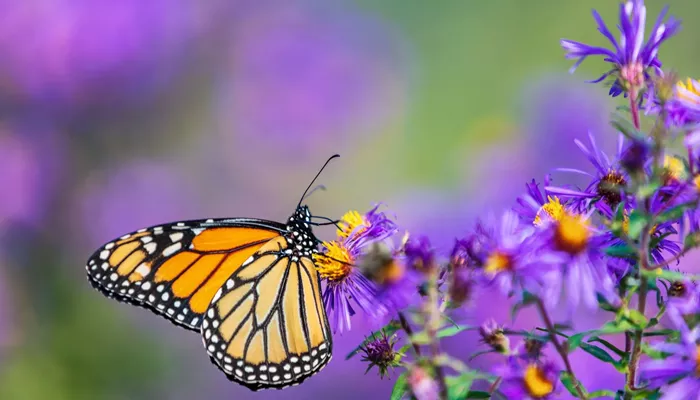Butterflies play a vital role in pollination, much like bees. They help transfer pollen between flowers, which is essential for plant reproduction. A garden designed to attract butterflies not only promotes biodiversity but also enhances the beauty of your outdoor space. Here’s how to create a butterfly-friendly garden.
Provide Nectar-Rich Flowers
Flowers are crucial for butterflies as they provide nectar, which is their main food source. According to horticulturist Peggy Anne Montgomery from Flowerbulb.eu, it’s best to include single-flowering species in your garden. These plants have a single row of petals that makes nectar easy to access for pollinators. Good examples include zinnias, coneflowers, and milkweed.
Montgomery warns that double-flowering varieties can hinder pollinators from reaching the nectar. While it’s fine to have both types of flowers, it’s essential to plant plenty of nectar-rich options for butterflies and other pollinators.
Include Host Plants
In addition to nectar, butterflies need host plants for reproduction. Each butterfly species prefers specific plants for laying eggs and feeding their larvae (caterpillars). Female butterflies lay their eggs on these plants, which serve as food for the hatching caterpillars.
Caterpillars rely solely on host plants to grow and eventually form pupae on them. They create a chrysalis and later emerge as adult butterflies.
Use Native Plants
Some butterfly species, like monarchs, migrate, while others are native to specific regions. Native butterflies depend on local host plants for their reproductive cycles and nourishment. Native plants have co-evolved with butterflies, providing the right nutrients for caterpillars to thrive. It’s important to research the butterfly species in your area and choose plants that support them. Non-native plants can be included, but they should support local wildlife and not be invasive.
Common Butterfly Species and Host Plants
In the United States, there are about 750 butterfly species. While some are native to specific regions, others are more widespread. Start by planting host plants that support native species in your area, then consider adding plants for other butterfly species:
Monarch: Milkweed
Swallowtail: Parsley, dill, and fennel
Painted Lady: Thistles and hollyhocks
Cabbage White: Cabbage and broccoli
Fritillaries: Violets
Include Early Spring Bloomers
Spring and summer are peak seasons for butterflies, providing ample natural resources. However, to attract them in late fall, winter, and early spring, careful planning is needed. Most butterflies hibernate as eggs, caterpillars, or pupae, while a few hibernate as adults.
Montgomery notes that butterflies typically become active when temperatures reach at least 65°F. Planting early-blooming bulbs in late fall—such as grape hyacinth, ornamental onions, anemones, and bluebells—will provide a food source for butterflies. Allium is particularly recommended because many varieties bloom at different times. Other early bloomers include dogwood, forsythia, lilacs, redbud, and Bleeding Heart.
Invest in Perennials for Easy Blooms
Perennials can add color and variety to your garden as they grow back each year, eliminating the need for replanting. Once established, they require little maintenance. While not all bulbs are perennial, many such as alliums, anemones, crocus, and Muscari are, and they attract butterflies.
Montgomery states that bulbs typically bloom for two to four weeks. To achieve continuous blooms, plant a variety of bulbs that flower at different times. Understanding your growing zone will help you select varieties that will keep your garden vibrant throughout the seasons.
Provide a Water Source
Water is essential for all life, but butterflies cannot drink from standing water. Instead, create a puddling station to provide butterflies with minerals and hydration.
To make a puddling station:
Fill a shallow pan or dish with dirt.
Add 1 teaspoon of salt.
If available, mix in a few spoonfuls of garden compost.
Slowly add water until the soil is thick and muddy.
Place small rocks on top for butterflies to land on.
Position the puddling station near flowering plants, and replenish it monthly to maintain moisture and nutrient levels.
Avoid Pesticides
Chemical pesticides can harm butterflies and other pollinators, either killing them or damaging their food sources. If pests appear, use a targeted approach. Regularly check your plants and remove pests by hand or with a strong water blast. For severe infestations, consider using milder insecticides like cold-pressed neem oil, which can control various pests without the harsh effects of synthetic chemicals. However, use neem oil cautiously, applying it early in the morning or late in the day to protect beneficial insects. Always follow package instructions carefully to avoid harming butterflies. Additionally, consider using beneficial insects or natural repellents to protect your garden while maintaining a butterfly-friendly environment.
Related topics:
- Going Away? How to Keep Your Plants Healthy While You’re Gone
- First Time Ever: Plants Shown Communicating with Each Other on Video
- Garden Club Focuses on Invasive Plants in Upcoming Program


